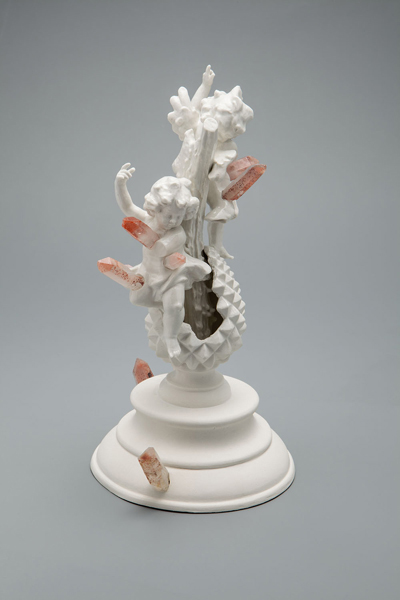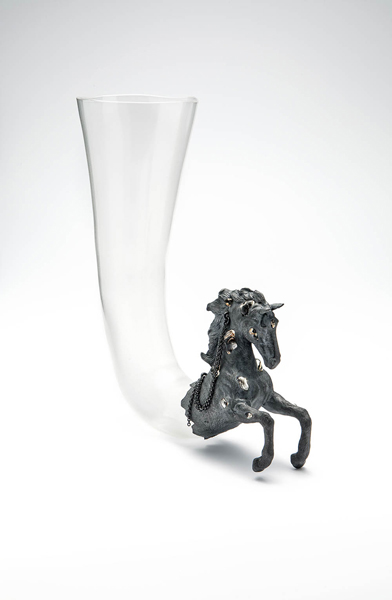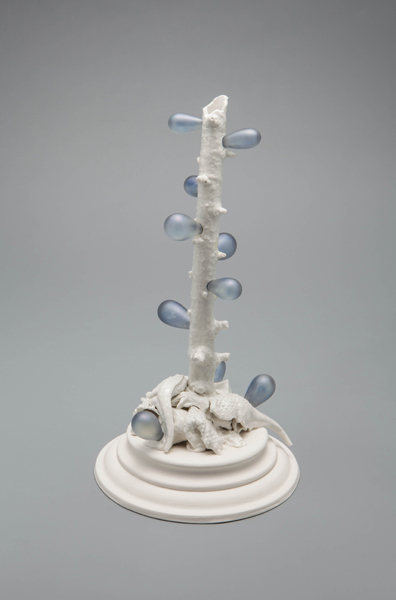Evert Nijland’s show at Galerie Rob Koudijs features imaginative and nostalgic objects. A Dutch jeweler, Evert loves the Rococo and Baroque styles of the past and so has reinterpreted them for the present in these ornamental objects. He is following an original path with this series, which veres away from the smooth Dutch style that has dominated the field in the Netherlands for decades. These “centerpieces” are really objects to be admired for their beauty and historical references.

Evert Nijland: The theme for this series is the so-called “centerpiece.” The topic “ornamental object” is for me a natural extension of my research into the meaning of the ornament. Ornamental objects, despite the fact that they are often in the form of a utensil such as a goblet or vase, have no real function other than propagating the conviction of what is viewed as beautiful in their time. This is a property that is also characteristic of the jewel. The ornament is, however, a broader understanding than the jewel alone; a piece of jewelry is always ornament but an ornament is not always a piece of jewelry.
You seem to have a distinct love for Baroque or Rococo styles. As a Dutch jeweler you appear to be playing against the stereotype of the Dutch attraction to the sleek and modern. Where did this love of these old ornamental styles come from?
Evert Nijland: When I started my education at the Rietveld Academie in 1990, it was modernism that ruled and was taught. Although I admired abstract painting, conceptual art, modernism, and functionalism, I felt a longing for something else—a form language that for me was more complex and seductive. Since my early childhood I was fascinated by the Renaissance and Baroque periods, and I just loved the costumes, the architecture, and the extravagant use of ornaments. But in the Netherlands around 1992, just as examples, furniture and glass design artist Borek Sipek and the photographer Erwin Olaf were starting to use curls and ornaments, and referred in their work to history. For me at that time, it was a great source of inspiration and made me feel a bit less abnormal!

Evert Nijland: Thank you. For the past five years, the Stokroos-Foundation has offered a grant to different artists such as Gesine Hackenberg and Piet Hein Eek with the aim of stimulating innovation in contemporary silver. For this year I was asked to experiment with the combination of silver and glass. With this assignment I could bring together two different disciplines of the applied arts. It was a great challenge not only to combine the two materials like I already did in my jewelry, but to look for another way to confront them with each other by blowing the glass directly through the hollow, silver forms. The result of this experiment is on display in the Dutch Silver Museum Schoonhoven, in the Netherlands, and one object is now part of the museum collection.
How did you work with the silver pieces in the museum collection? Do specific pieces in this show relate to specific pieces in the Silver Museum in Schoonhoven?
Evert Nijland: In the museum collection, you can find some good examples of 19th century centerpieces made out of silver, which were used at that time to decorate the dining table. The object Birds I made for this show relates to an extravagant piece in the museum collection that consists of a giant silver tree covered with ornaments supporting a crystal plate.
Each work in this show looks like it has been ravaged by time. Ribbons and Rococo are both showing signs of damage. Why not make them perfect?
Evert Nijland: For me it is a challenge to visualize the natural process of transformation through time. The objects strongly refer to history but it is the combination between past and present, figuration and abstraction that interests me. This work is made as a comment on classical archetypes and symbols that are still part of our culture today. It is fascinating that a material such as porcelain contains a strong, cultural load, and by breaking it and showing only fragments I tried to visualize the contrast between form and emptiness.

Evert Nijland: The rhyton is another classical archetype, used in antiquity as a ritual object. I wanted to make a contemporary version of it by using a plastic toy horse as a model. The model was first cast in wax in which I made holes. This hollow wax model was then cast in silver, and after that the holes were filled from the inside out with glass. The glass represents for me the inner force and energy that wants to come out.
Why did you call the show Ascendance?
Evert Nijland: All the examples of classical ornamental objects I refer to in Ascendance have a strong, well-founded base, on which many different elements are attached to create volume. Looking at them, I experience an expression of movement and energy that wants to ascend. I took over the same concept and structure for this series to create objects in a vertical direction.
You are an artist who works with other artists or artisans to make your pieces. Can you describe the process you went through to produce these and talk about the people you worked with?
Evert Nijland: To produce the silver/glass pieces I worked both with a silver casting company and lamp/glassblower Edwin Dieperink. It was a great challenge for us to find the right method for blowing the glass directly in the silver cast forms. Fortunately we found out that the two materials love each other. The melting point of silver is higher than that of glass, so we could meld the glass without burning and damaging the silver, and the glass, after the cooling down, now being attached to the silver, did not crack.
What are you reading, seeing, and listening to?
At the moment I am reading a biography called Anna, written by Annejet van der Zijl about the Dutch author Annie M.G. Schmidt. She is very famous in the Netherlands for her children’s books, which are still very popular today.
The last exhibition I saw is called Dining with the Tsars, about the dining culture at the Russian court at Saint Petersburg, at the Hermitage Amsterdam. I listen to music a lot because it is very important to me, and at the moment the piano concerts by Mozart are my favorites.





